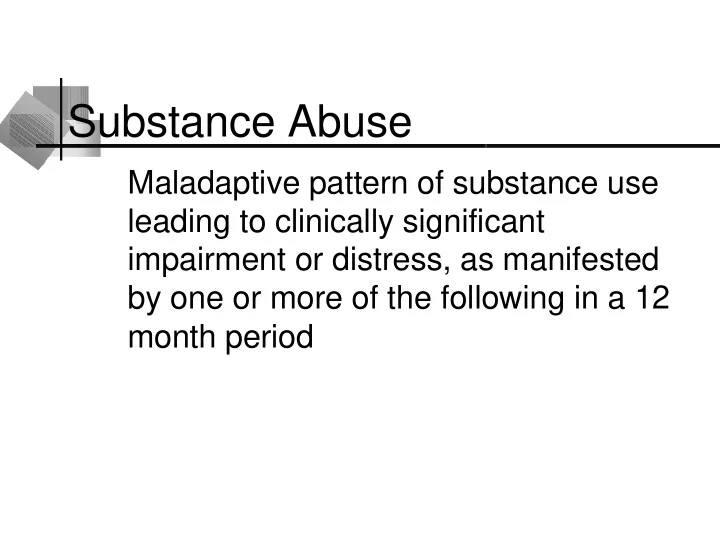

Substance Abuse Maladaptive pattern of substance use leading to clinically significant impairment or distress, as manifested by one or more of the following in a 12 month period
Substance Abuse � 1. Recurrent substance use leading to failure to fulfill major role obligations at work, school, or home � 2. Recurrent substance use in situations in which it is physically hazardous � 3. Recurrent substance related legal problems � 4. Continued substance use despite having persistent or recurrent social or interpersonal problems caused by or exacerbated by the effects of substances
Substance Dependence A maladaptive pattern of substance use leading to clinically significant impairment or distress, as manifested by three or more of the following, occurring at any time in the same 12 month period
Substance Dependence 1. Tolerance � 2. Withdrawal � 3. Substance is often taken in larger amounts over a longer � period of time than was intended 4. There is a persistent desire or unsuccessful efforts to cut � down or control substance use 5. A great deal of time is spent in activities to obtain, use, or � recover from the effects of substance 6. Important social, occupational, or recreational are given up or � reduced because of substance use 7. Substance use is continued despite knowledge of having a � persistent or recurrent physical or psychological problem that is likely to have been caused or exacerbated by substance use
Criteria for Substance Intoxication � A. Development of a reversible substance-specific syndrome due to recent ingestion of ( or exposure to) a substance. Note: Different substances may produce similar or identical syndromes. � B. Clinically significant maladaptive behavioral or psychological changes that are due to the effect of the substance on the central nervous system (e.g., belligerence, mood lability, cognitive impairment, impaired social or occupational functioning) and develop during or shortly after use of the substance. � C. The symptoms are not due to a general medical condition and are not better accounted for by another mental disorder.
Criteria for Alcohol Intoxication Maladaptive behavioral or psychological changes that developed during or shortly after alcohol ingestion, and one or more of the following: A. Slurred speech � B. Incoordination � C. Unsteady gait � D. Nystagmus � E. Impairment in attention or memory � F. Stupor or coma �
Criteria for Amphetamine Intoxication Maladaptive behavioral or psychological changes that developed during or shortly after amphetamine ingestion (euphoria or affective blunting; changes in sociability; hypervigilance; interpersonal sensitivity; anxiety, tension, or anger; stereotyped behaviors; impaired judgement), and two or more of the following: A. Tachycardia or bradycardia � B. Pupillary dilation � C. Elevated or lowered blood pressure � D. Perspiration or chills � E. Nausea or vomiting � F. Evidence of weight loss � G. Psychomotor agitation of retardation � H. Muscular weakness, respiratory depression, chest pain, or cardiac � arrhythmias � I. Confusion, seizures, dyskinesias, dystonias, or coma �
Criteria for Cannabis Intoxication Maladaptive behavioral or psychological changes that developed during or shortly after cannabis use(impaired motor coordination, euphoria, anxiety, sensation of slowed time, impaired judgement, social withdrawal), and two or more of the following developed within two hours of use: A. Conjunctival injection � B. Increased appetite � C. Dry mouth � D. Tachycardia �
Criteria for Hallucinogen Intoxication Maladaptive behavioral or psychological changes that developed during or shortly after hallucinogen use(marked anxiety or depression, ideas of reference, fear of losing one’s mind, paranoid ideation, impaired judgement. Perceptual changes occurring in a state of full wakefulness and alertness (subjective intensification of perceptions, depersonalization, derealization, illusions, hallucinations, synesthesias). Two or more of the following: A. Papillary dilation � B. Tachycardia � C. Sweating � D. Palpitations � E. Blurring of vision � F. Tremors � G. Incoordination �
Criteria for Opioid Intoxication Maladaptive behavioral or psychological changes that developed during or shortly after opioid use(initial euphoria followed by apathy, dysphoria,psycomotor agitation or retardation,impaired judgement). Pupillary constriction ( or pupillary dilation due to anoxia) and one or more of the following: A. Drowsiness or coma � B. Slurred speech � C. Impairment in attention or memory �
Criteria for Substance Withdrawal � A. The development of a substance-specific syndrome due to the cessation of ( or reduction in) substance use that has been heavy and prolonged. B. The substance-specific syndrome causes � clinically significant distress or impairment in social, occupational, or other important areas of functioning. C. The symptoms are not due to a general � medical condition and are not better accounted for by another mental disorder
Criteria for Alcohol Withdrawal Cessation of or reduction in use of alcohol that has been heavy and prolonged, and two or more of the following developing within several hours to several days after cessation of use: A. Autonomic hyperactivity ( sweating or pulse rate greater that � 100) B. Increased hand tremor � C. Insomnia � D. Nausea or vomiting � E. Transient visual, tactile, or auditory hallucinations � F. Psychomotor agitation � G. Anxiety � H. Grand mal seizures �
Criteria for Amphetamine Withdrawal Cessation of or reduction in use of amphetamine that has been heavy and prolonged, and dysphoric mood along with two or more of the following developing within several hours to several days after cessation of use: A. Fatigue � B. Vivid unpleasant dreams � C. Insomnia or hypersomnia � D. Increased appetite � E. Psychomotor agitation or retardation �
Criteria for Opioid Withdrawal Either cessation of or reduction in use of opioids that has been heavy and prolonged or administration of an opioid antagonist after a period of opioid use along with three of the following: A. Dysphoric mood � B. Nausea or vomiting � C. Muscle aches � D. Lacrimation or rhinorrhes � E. Pupillary dilation, piloerection, or sweating � F. Diarrhea � G. Yawning � H. Fever � I. Insomnia �
Recommend
More recommend